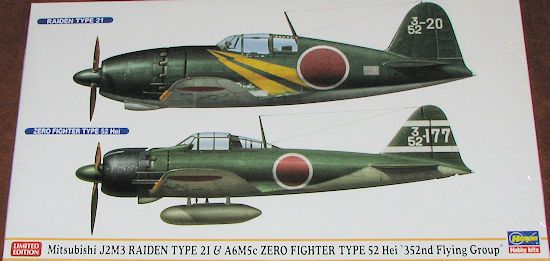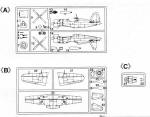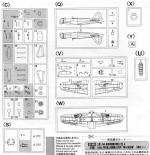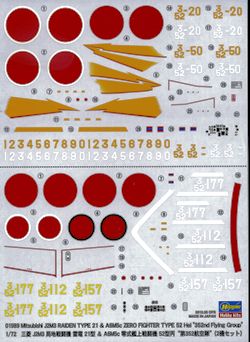
Hasegawa 1/72 J2M3 & A6M5c '352nd Flying Group' Combo
| KIT #: | 01989 |
| PRICE: | $23.00 on sale ($49.99 SRP) |
| DECALS: | Three options |
| REVIEWER: | Scott Van Aken |
| NOTES: |
Combo kit, 2012 boxing |

| HISTORY |
As any Allied pilot flying in the Pacific or CBI theaters who managed to shoot down or sight an enemy plane, and they'll say it was a Zero, even if there wasn't one for a thousand miles. That is how much the Mitsubishi A6M has been ingrained into our psyche. While the various versions of the Zero were the most widely produced Japanese aircraft, total builds or less than 10,000 aircraft were pale when compared to the Yak or 109, for which three times that number were produced. However, like those two aircraft, there were a rather bewildering number of different variants.
The final main version and probably most produced base airframe was the A6M5, which had shorter wings of greater cord and started incorporating some pilot armor and fuel tank protection that was sorely needed, though at a loss of range and maneuverability that the Japanese so loved. The A6M5c, the subject of this kit, was probably the most heavily armed of the series and as such was not the most maneuverable of the series. However, it was the Zero that pretty much was the version used for the last years of the war.
The other kit in this combo is the J2M3 'Jack'.
Per the
Hasegawa folks: “Feeling the need for a high-speed, quick climbing interceptor
work began in 1938 on what was to become the Raiden (Thunderbolt).
Total production of all variants totaled approximately 500 by war’s end.
In service, the Raiden, code named “Jack” by the allies –proved a fine aircraft
and it was the preferred bomber-destroyer of IJN pilots late in the war, where
it frequently faced incoming
| THE KITS |


The A6M5c kit is at least a decade newer in its
engineering so you will find the usual inserts and other spare bits to ensure
you are doing the proper plane. This kit has a different lower wing that
includes the bomb racks on the outer wings that were standard on the A6M5c as well as the cowling with the two
larger openings. Again, there are decals for instruments in a rather basic
cockpit, but no pilot figure in this one. All of the wing gun barrels are
separate to help in painting the yellow leading edges.
outer wings that were standard on the A6M5c as well as the cowling with the two
larger openings. Again, there are decals for instruments in a rather basic
cockpit, but no pilot figure in this one. All of the wing gun barrels are
separate to help in painting the yellow leading edges.
This version takes the 'winged' drop tanks with the 'wings' removed. The tail hook area is also to be filled in and sanded smooth. There are going to be quite a few bits left over as is normal with modern kits. Like the J2M, a single piece canopy is provided. This one also has all the tail code options in both yellow and white. There are three options on the A6M, all in the same colors as the J2M which is Mitsubishi Dark Green over Grey-Green. These are quite similar with only stripes or lack of to differentiate from the markings options. The decals in this set have been darkened to show the white and these are very much the newer type so should work well with your various setting solutions. I should also add that there are separate instructions for each aircraft type though the sheet is one for the two.
| CONCLUSIONS |
It seems as if these combo kits are becoming more and more a part of the Hasegawa inventory and thanks to deep discounts like this one, I have several in my collection. Both kits are worth of being built and I would bet there is aftermarket for them. A resin cockpit would be a major improvement if you can locate one. Overall, it is a worthy kit if found on discount. No way would I fork over $50 for these at retail.
June 2013
Thanks to me for grabbing this one on sale.
If you would like your product reviewed fairly and fairly quickly, please contact the editor or see other details in the Note to Contributors.